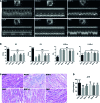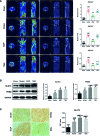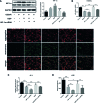Danqi Pill Protects Against Heart Failure Post-Acute Myocardial Infarction via HIF-1α/PGC-1α Mediated Glucose Metabolism Pathway
- PMID: 32372956
- PMCID: PMC7187888
- DOI: 10.3389/fphar.2020.00458
Danqi Pill Protects Against Heart Failure Post-Acute Myocardial Infarction via HIF-1α/PGC-1α Mediated Glucose Metabolism Pathway
Abstract
Aim: Heart failure (HF) post-acute myocardial infarction (AMI) leads to a large number of hospitalizations and deaths worldwide. Danqi pill (DQP) is included in the 2015 national pharmacopoeia and widely applied in the treatment of HF in clinics in China. We examined whether DQP acted on glucose metabolism to protect against HF post-AMI via hypoxia inducible factor-1 alpha (HIF-1α)/peroxisome proliferator-activated receptor α co-activator (PGC-1α) pathway.
Methods and results: In this study, left anterior descending (LAD) artery ligation induced HF post-AMI rats and oxygen-glucose deprivation-reperfusion (OGD/R)-induced H9C2 cell model were structured to explore the efficacy and mechanism of DQP. Here we showed that DQP protected the heart against ischemic damage as evidenced by improved cardiac functions and attenuated inflammatory infiltration. The expressions of critical proteins involved in glucose intake and transportation such as GLUT4 and PKM2 were up-regulated, while negative regulatory proteins involved in oxidative phosphorylation were attenuated in the treatment of DQP. Moreover, DQP up-regulated NRF1 and TFAM, promoted mitochondrial biogenesis and increased myocardial adenosine triphosphate (ATP) level. The protection effects of DQP were significantly compromised by HIF-1α siRNA, suggesting that HIF-1α signaling pathway was the potential target of DQP on HF post-AMI.
Conclusions: DQP exhibits the efficacy to improve myocardial glucose metabolism, mitochondrial oxidative phosphorylation and biogenesis by regulating HIF-1α/PGC-1α signaling pathway in HF post-AMI rats.
Keywords: Danqi Pill (DQP); HIF-1α/PGC-1α pathway; acute myocardial infarction (AMI); glucose metabolism; heart failure (HF).
Copyright © 2020 Zhang, Guo, Wang, Wang, Wang, Wu, Li, Wang and Wang.
Figures






Similar articles
-
The Effect of Chinese Medicine on Lipid and Glucose Metabolism in Acute Myocardial Infarction Through PPARγ Pathway.Front Pharmacol. 2018 Oct 24;9:1209. doi: 10.3389/fphar.2018.01209. eCollection 2018. Front Pharmacol. 2018. PMID: 30405421 Free PMC article.
-
The effect of Chinese herbs and its effective components on coronary heart disease through PPARs-PGC1α pathway.BMC Complement Altern Med. 2016 Dec 12;16(1):514. doi: 10.1186/s12906-016-1496-z. BMC Complement Altern Med. 2016. PMID: 27955667 Free PMC article.
-
The roles of the mitophagy inducer Danqi pill in heart failure: A new therapeutic target to preserve energy metabolism.Phytomedicine. 2022 May;99:154009. doi: 10.1016/j.phymed.2022.154009. Epub 2022 Feb 18. Phytomedicine. 2022. PMID: 35217438
-
Identification of the active compounds and drug targets of Chinese medicine in heart failure based on the PPARs-RXRα pathway.J Ethnopharmacol. 2020 Jul 15;257:112859. doi: 10.1016/j.jep.2020.112859. Epub 2020 Apr 12. J Ethnopharmacol. 2020. PMID: 32294506
-
Adenosine triphosphate-induced cell death in heart failure: Is there a link?World J Cardiol. 2025 Apr 26;17(4):105021. doi: 10.4330/wjc.v17.i4.105021. World J Cardiol. 2025. PMID: 40308621 Free PMC article. Review.
Cited by
-
Astragaloside IV protects cardiomyocytes against hypoxia injury via HIF-1α and the JAK2/STAT3 pathway.Ann Transl Med. 2021 Sep;9(18):1435. doi: 10.21037/atm-21-4080. Ann Transl Med. 2021. PMID: 34733987 Free PMC article.
-
Synergistic Effects of Ginsenoside Rb3 and Ferruginol in Ischemia-Induced Myocardial Infarction.Int J Mol Sci. 2022 Dec 14;23(24):15935. doi: 10.3390/ijms232415935. Int J Mol Sci. 2022. PMID: 36555577 Free PMC article.
-
Shakuyaku-Kanzo-To Prevents Angiotensin Ⅱ-Induced Cardiac Hypertrophy in Neonatal Rat Ventricular Myocytes.Cureus. 2024 Nov 20;16(11):e74064. doi: 10.7759/cureus.74064. eCollection 2024 Nov. Cureus. 2024. PMID: 39712736 Free PMC article.
-
Targeting PRMT1-mediated methylation of TAF15 to protect against myocardial infarction by inhibiting ferroptosis via the GPX4/NRF2 pathway.Clin Epigenetics. 2025 Jul 22;17(1):129. doi: 10.1186/s13148-025-01935-8. Clin Epigenetics. 2025. PMID: 40696470 Free PMC article.
-
RNA-Seq Profiling to Investigate the Mechanism of Qishen Granules on Regulating Mitochondrial Energy Metabolism of Heart Failure in Rats.Evid Based Complement Alternat Med. 2021 Dec 31;2021:5779307. doi: 10.1155/2021/5779307. eCollection 2021. Evid Based Complement Alternat Med. 2021. PMID: 35003305 Free PMC article.
References
-
- Ambrose L. J., Abd-Jamil A. H., Gomes R. S., Carter E. E., Carr C. A., Clarke K., et al. (2014). Investigating mitochondrial metabolism in contracting HL-1 cardiomyocytes following hypoxia and pharmacological HIF activation identifies HIF-dependent and independent mechanisms of regulation. J. Cardiovasc. Pharmacol. Ther. 19, 574–585. 10.1177/1074248414524480 - DOI - PubMed
LinkOut - more resources
Full Text Sources
Research Materials
Miscellaneous

